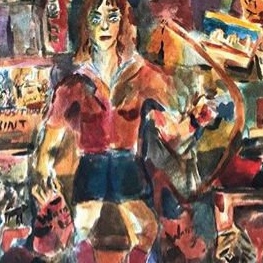
SA

This is no deranged prophet, but a strong and courageous artist
DANNY SHORKEND
As I walked around the Max Wolpe’s 11 exhibition at the South African Jewish Museum in Cape Town last week, my initial impression was indifference. There seemed to be an almost depressed colour scheme, a certain heaviness and lethargy. But as I spent more time on the works, they began to grow on me. Before I had time to analyse the portend of the subject matter, I began to sense the impression the artist creates via his hand.
Most of the work is in oil on board or canvas, but Wolpe is equally adept at watercolour, etching and aquatint, woodcut, aquarelle and ink on various kinds of paper. And as the skill of the craft, particularly his drawing, emerged, so the soggy, dusty, all-over sameness began to transform.
Some of the paintings even began to sing, with light becoming apparent. Then I noticed in many works a playful, musical, almost humorous quality as faces – caricatured and yet humane – peeked out amidst a turbulent, almost claustrophobic space.
Yet this is not stifling. One can breathe as texture, line and semi-abstract – an almost reductive, child-like quality – give Wolpe’s work a sense of witty charm.
The somewhat “unfinished” quality of the work (its congested flurry), what some have erroneously dubbed as naïve, contains and harmonises a contradiction in his work which is the source of its beauty – namely, that his work can be defined as rough, direct, expressive, “impatient” and yet be simultaneously subtle and resolved. This contradiction, what one might call its simple complexity, means that somehow my initial depression is yet charged with a certain mindful energy.
It is perhaps the energy of the artist as “outsider”, as merely an observer, as not complicit with conventional rules. I take exception to the exhibition blurb on the gallery wall that defines such a position further, such that the artist is mad, as some sort of deranged prophet. It’s a definition debunked as untenable by much contemporary art theory and history. Such ideas need not be taken lightly.
Perhaps the highlight of the show is Wolpe’s “Ox” (1990), a sculpture in corrugated cardboard and cold glue. It is testimony to his strength, endurance and courage, for there is a price to paid for following the muse(s) of art. The ox stands resolute and poised.
Perhaps, if one were to concede the outsider definition, Wolpe often seems to be looking at societal structures and personality types with a keen eye for cityscapes, the carnival and the hum of crowds.
At the same time, there is introspection, loneliness and solitude. Perhaps the artist is a kind of social scientist. Wolpe’s methods are alive with a human touch, a human lens and an open heart. In shunning contemporary digital technologies, his voice ought to be heard against the tremor of potential clinical coldness and the transformation of every human feeling and idea into a brand, product or service.
Art has, for much of its history, a bitter-sweet relationship with institutional systems of control and coercion, as well as with commerce. Art has itself not always been innocent in that power game. Perhaps Wolpe has managed to circumvent the system.
- Max Wolpe’s 11 is on display at the South African Jewish Museum until June 10




